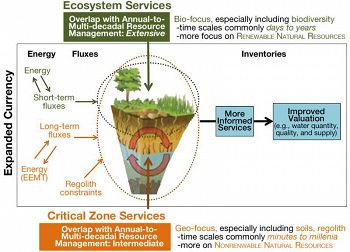Field et al., 2015
Critical Zone Services: Expanding Context, Constraints, and Currency beyond Ecosystem Services
Field J.P., Breshears D.D., Law D.J., Villegas J.C., López-Hoffman L., Brooks P.D., Chorover J., Barron-Gafford G.A., Gallery R.E., Litvak M.E., Lybrand R.A., McIntosh J.C., Meixner T., Niu G-Y., Papuga S.A., Pelletier J.D., Rasmussen C.R., and Troch P.A (2015)
Vadose Zone Journal 14(1)
-
Catalina-Jemez, INVESTIGATOR
-
Catalina-Jemez, INVESTIGATOR
-
Catalina-Jemez, INVESTIGATOR, COLLABORATOR
-
Catalina-Jemez, INVESTIGATOR
-
Catalina-Jemez, INVESTIGATOR
-
Catalina-Jemez, INVESTIGATOR
-
Catalina-Jemez, INVESTIGATOR
-
Calhoun, Catalina-Jemez, COLLABORATOR
-
Catalina-Jemez, INVESTIGATOR
-
Catalina-Jemez, INVESTIGATOR
-
Catalina-Jemez, INVESTIGATOR, COLLABORATOR
-
Catalina-Jemez, INVESTIGATOR
-
Catalina-Jemez, INVESTIGATOR
-
Catalina-Jemez, INVESTIGATOR
-
Catalina-Jemez, INVESTIGATOR
Abstract
Critical zone services provide context, constraints, and currency that enable more effective management and valuation of ecosystem services (adapted from Millennium Ecosystem Assessment (MEA), 2005)
Processes within the critical zone, such as soil formation, support and/or control many ecosystem processes and consequently the supply of products that benefits society. An expanded perspective of ecosystem services that encompasses the critical zone would enable more effective management and allow a more comprehensive valuation of services.
Processes within the critical zone—spanning groundwater to the top of the vegetation canopy—have important societal relevance and operate over broad spatial and temporal scales that often are not included in existing frameworks for ecosystem services evaluation. Here we expand the scope of ecosystem services by specifying how critical zone processes extend context both spatially and temporally, determine constraints that limit provision of services, and offer a potentially powerful currency for evaluation. Context: A critical zone perspective extends the context of ecosystem services by expressly addressing how the physical structure of the terrestrial Earth surface (e.g., parent material, topography, and orography) provides a broader spatial and temporal template determining the coevolution of physical and biological systems that result in societal benefits. Constraints: The rates at which many ecosystem services are provided are fundamentally constrained by rate-limited critical zone processes, a phenomenon that we describe as a conceptual “supply chain” that accounts for rate-limiting soil formation, hydrologic partitioning, and streamflow generation. Currency: One of the major challenges in assessing ecosystem services is the evaluation of their importance by linking ecological processes to societal benefits through market and nonmarket valuation. We propose that critical zone processes be integrated into an evaluation currency, useful for valuation, by quantifying the energy flux available to do thermodynamic work on the critical zone. In short, characterization of critical zone processes expands the scope of ecosystem services by providing context, constraints, and currency that enable more effective management needed to respond to impacts of changing climate and disturbances.
Citation
Field J.P., Breshears D.D., Law D.J., Villegas J.C., López-Hoffman L., Brooks P.D., Chorover J., Barron-Gafford G.A., Gallery R.E., Litvak M.E., Lybrand R.A., McIntosh J.C., Meixner T., Niu G-Y., Papuga S.A., Pelletier J.D., Rasmussen C.R., and Troch P.A (2015): Critical Zone Services: Expanding Context, Constraints, and Currency beyond Ecosystem Services. Vadose Zone Journal 14(1). DOI: 10.2136/vzj2014.10.0142
 This Paper/Book acknowledges NSF CZO grant support.
This Paper/Book acknowledges NSF CZO grant support.
Explore Further
















